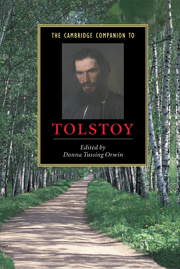Book contents
- Frontmatter
- Chronology
- Introduction
- Part 1 The three novels
- Part 2 Genres
- Part 3 General topics
- 7 The development of style and theme in Tolstoy
- 8 History and autobiography in Tolstoy
- 9 Women, sexuality, and the family in Tolstoy
- 10 Tolstoy in the twentieth century
- 11 Courage in Tolstoy
- 12 Tolstoy’s aesthetics
- Guide to further reading
- Index to Tolstoy’s works and characters
- Generel Index
9 - Women, sexuality, and the family in Tolstoy
from Part 3 - General topics
Published online by Cambridge University Press: 28 May 2006
- Frontmatter
- Chronology
- Introduction
- Part 1 The three novels
- Part 2 Genres
- Part 3 General topics
- 7 The development of style and theme in Tolstoy
- 8 History and autobiography in Tolstoy
- 9 Women, sexuality, and the family in Tolstoy
- 10 Tolstoy in the twentieth century
- 11 Courage in Tolstoy
- 12 Tolstoy’s aesthetics
- Guide to further reading
- Index to Tolstoy’s works and characters
- Generel Index
Summary
In Tolstoy’s artistic pursuit of the meaning of human life, femaleness plays a crucial, if not always enviable, role. Especially in the first half of his writing career Tolstoy created female characters who often embodied the potent and volatile emotions aroused by love. Studied both as individuals and as a chronological aggregate, these heroines rehearse and refine over time a quest to find and put into practice the elusive concept of “true love.” This search almost invariably assumes transgression.
A major impediment to a full reading of Tolstoy’s fiction, especially to his writing on women, centers on a tendency to equate his art and his life, that is to say, to interpret his art as a barely disguised annotation to his personal beliefs. According to one such view, Tolstoy’s contempt for women’s liberation (called in nineteenth-century Russia “the women question”) finds fictional expression in his ideally virtuous mothers - most conspicuously Natasha in War and Peace and Kitty in Anna Karenina - whose preoccupation with their children satisfies all needs and desires and exhausts all creative potential. Following this line of thinking, Anna Karenina – despite any sympathetic traits she may possess – is condemned because she subverts her biologically determined maternal role and destroys the sanctity of her family. For this violation of natural law, she must die.
- Type
- Chapter
- Information
- The Cambridge Companion to Tolstoy , pp. 191 - 205Publisher: Cambridge University PressPrint publication year: 2002
- 4
- Cited by



